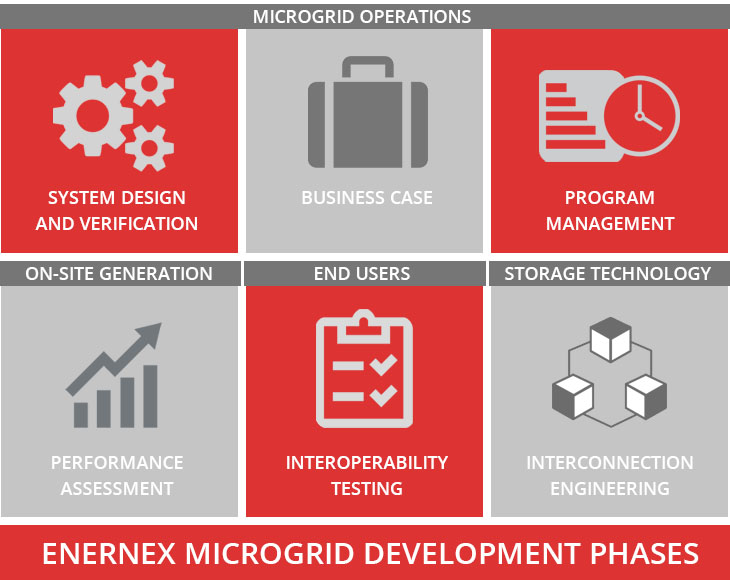Fault Induced Delayed Voltage Recovery (FIDVR) Phenomenon:
Modeling and Guidelines
 By: Sarina Adhikari, Senior Consultant
By: Sarina Adhikari, Senior Consultant
sadhikari@enernex.com
865-218-4600 x6177
Broadly speaking, voltage sensitive loads are classified into two different categories: static or steady state, and dynamic loads. Accurate modeling of loads in the simulation environment that can closely mimic the behavior of the real-world load dynamics is a big modeling challenge. Bonneville Power Administration (BPA) and Western Electricity Coordinating Council (WECC) developed the Composite Load Model structure comprising of different types of static loads, electronic loads, three phase and single-phase compressor motor loads. The main drivers of the phenomenon termed as Fault Induced Delayed Voltage Recovery (FIDVR) are single phase low inertia compressor motors.
The phenomenon in which the system voltage remains at excessively low levels for the duration of several seconds, even after the clearing of a transmission, sub transmission, or distribution fault are classified as FIDVR events. In a system with large percentage of single-phase induction motor loads with constant torque characteristics, the motor stalls when the system voltage dips to some low values during the fault conditions. These type of low inertia motors draw huge amount of reactive power from the grid during the depressed voltage conditions. These motors draw 5-6 times their steady state current in this stalled or locked-rotor condition. As a result, the system voltage remains at the depressed state for a long time until the thermal protection kicks in and trips the single-phase motor loads. Once the motors are taken out of the system, the system voltage gradually recovers. It can take as long as 30 seconds for the system voltage to get back to normal during the FIDVR phenomenon. The aftermath of FIDVR event could be voltage collapse and several cascading events on the electrical power system. These type events typically occur in the peak hot summer days when there are large number of single-phase air conditioning (A/C) compressor motors in operation.
The illustration of a typical FIDVR event showing successive sequence of events is provided in Figure 1. It shows a typical delayed voltage recovery profile on a 230 KV circuit located in Southern California following a fault. The voltage decreased to around 79 percent of the nominal voltage (as pointed by 1) following the fault. This reduction in voltage caused the A/C units to stall. These stalled A/C units depressed the system voltage from the nominal voltage level (as pointed by 2). As the thermal overload protection switches of the A/C units were operated by tripping the units off the connected system, the voltage recovered to the value higher than the nominal by around 6 percent in this case (as pointed by 3).

Figure 1: Typical delayed voltage recovery event that was recorded following a 230kV transmission fault in Southern California[1]
As some of the motor loads tripped out of the system while the capacitor banks were still online, voltage response overshoot was observed. The overvoltage condition, in turn, resulted in the tripping of some capacitor banks and made the load side transformer taps to operate as shown in point 4. This helped in decreasing the initial voltage overshoot to some extent. After some interval, the loads, including the A/C loads, began to reconnect back to the system. As some of the capacitor banks had already tripped, the system voltage went below the nominal voltage as shown by the points 5 and 6 in the figure. These types of conditions make the system vulnerable to voltage collapse followed by other cascading events. The light inertia induction motors, such as air conditioner motors, lose their speed rapidly following the voltage dip conditions. According to the test results, such motors will stall for all faults with the duration more than five cycles and the voltage dip magnitude less than 60% of the nominal voltage.
EnerNex developed a computer simulation model in GE PSLF by utilizing the composite load model that replicated the FIDVR event in the Valley substation of Southern California Edison (SCE) that occurred in 2004. Figure 2 shows the voltage profile at 115 kV Valley bus measured by the Phasor Measurement Unit (PMU) as compared to the one obtained from the developed PSLF Valley aggregated system model with WECC parameterized composite load model. It shows that with the proper choice of model parameters, it is possible to replicate the real world FIDVR event in the computer simulation environment. It was also proved that loss of voltage sensitive loads in the system is a key factor in replicating these types of FIDVR events.

Figure 2: Measured Vs Simulated voltage profile at Valley 115kV bus during the FIDVR event at Valley station of Southern California Edison (SCE).
A detailed sensitivity analysis of different parameters of the composite load model on the system voltage profile was performed as well. In summary, the most sensitive parameters that affect voltage response of a system with large percentage of single-phase A/C compressor motors fall into the following categories:
- Thermal contactor trip characteristics
- Thermal time constants
- Undervoltage protection characteristics
- Single-phase machine stall characteristics (Vstall, Tstall)
Based on the results of sensitivity analysis of various parameters of three-phase and single-phase compressor A/C motor loads, we produced a guideline showing some typical values of different parameters to replicate the real world FIDVR events. We have also presented a broad guideline for steady state cascading simulations.
Significant Contributions:
The major outcomes of this work are summarized below:
- A validated computer simulation model with the WECC composite load model developed in GE PSLF platform.
- Detailed sensitivity analysis of the effects of different composite load model parameters on system voltage response.
- A general guideline about the most sensitive composite load model parameters and typical values of those parameters that are required to replicate the real world FIDVR type events in computer simulations.
- A detailed guideline on simulations of steady state cascading events.
- A proof of concept that actual practical system events cannot be replicated without modeling the loss of voltage-sensitive load in the system.
[1] Source: R. Bravo, R. Yinger, D. Chassin, H. Huang, N. Lu, I. Hiskens, and G. Venkataramanan, “ Final Project Report – Load Modeling Transmission Research”, Lawrence Berkeley National Laboratory (LBNL), March 2010, [Online] Available: https://web.eecs.umich.edu/~hiskens/publications/LM_Final_Report.pdf (Last Accessed: Nov 05, 2018)


